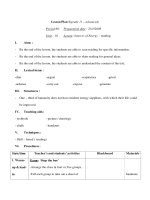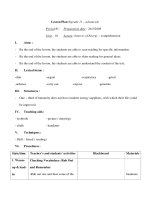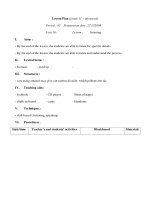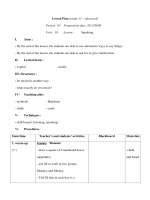Bài soạn môn học Tiếng Anh khối lớp 11 - Unit 10: Staying healthy - Section A, B
Bạn đang xem bản rút gọn của tài liệu. Xem và tải ngay bản đầy đủ của tài liệu tại đây (78.58 KB, 7 trang )
<span class='text_page_counter'>(1)</span>-1-. UNIT 10: STAYING HEALTHY SECTION A: HOW DO YOU FEEL? I. OBJECTIVES: Students can express their feelings, their need and know how to use adjectives and modal “would like”. II. CONTENT: 1. Language material: A/ Structure: How do you feel? - I’m hungry How does he feel? - He feels tired. What would you like? - I’d like some orange juice. What do you want? - I want a hot drink What does he/she want? - He/she wants a cold drink. B/ Vocabulary: juice hungry hot noodles thirsty cold a drink full tired. feel would like want need 2.Language skills: Litening – speaking – reading – writing 3.Teaching method: Communicative approach 4.Teaching aids: Cassettes – Pictures 5.Teaching steps:. A.1-2 Listen and repeat. empty. Teacher’s activities. Students’ activities. - Shows students the pictures and asks the questions. “What’s he/she doing?”. Look at the pictures and listen to the teacher’s questions. Try to answer the questions.. “How does he/she feel?”. Repeat the new adjectives. “How do you feel?” Explains the meanings of the questions and help them to answer / expresses their feelings.. Lop11.com. Express your own feelings. Work in pairs. Write the sentences in the notebook..
<span class='text_page_counter'>(2)</span> -2 Uses the structures S + am/is/are + adjective.. Take notes and memorize. Notes. How do you feel? I’m hungry Says the new adjectives and How does he feel? He’s tired. asks them to guess the meanings. How + do/does + S + feel? Has them repeat and work in pairs.. S + am/is/are + adjective. What would you like?. Lets them take notes and I would like… memorize I’d like… Tells the students to work in - Work in pairs. pairs ( one asks, one answers) - Plays the cassette. Has students listen carefully with books closed Lets them repeat the sentences. Lets them open the books and read the dialogue Has some of them play the role of Lan, Nam and Ba. Listen carefully Books closed.. A.4 Ask and answer. - Asks them to close the books and practice in pairs, ask and answer about Nam, Lan and Ba.. Ask questions and answer about Nam, Lan and Ba. A.5 Matching. - Has them listen to the cassette and write the names and letters of the pictures in the notebook. Key: Phuong: b, Nhan: a, Ba: f, Huong: d. Listen to the cassette, then write the names and letters of the pictures in the notebook.. A.3 Listen and repeat. Lop11.com. Repeat the sentences. Open the books and read the dialogue by themselves. Listen to their classmates. Try to remember the main ideas. Practices in pairs.. Write the dialogue.
<span class='text_page_counter'>(3)</span> -3A.6 Listen and repeat. - Asks them to listen to the dialogue. Use the cues given to make new dialogues and practice in pairs.. Listen to the dialogue Make new dialogue with your partner. Make some more new dialogues. A.7. - Read the verses aloud. Have them reread and copy in their notebook. Read the verses. Copy and learn by heart.. SECTION B: FOOD AND DRINK. I.. OBJECTIVES: Students know the names of some food and drink. They can tell what they want or they would like. They learn how to use “some” and “any”. II. CONTENT: 1. Language material: A. Structure: Is there any meat? Yes, there’s some meat. No, there isn’t any milk. Are there any noodles? Yes, there are some noodles. No, there aren’t any bananas What would you like? I’d like some milk. What is there to drink/to eat? There’s some water. B.Vocabulary: apple rice chicken some orange vegetable fish any banana meat bread water milk orange juice. 2. Language skills: Listening – speaking – reading - writing 3. Teacing method: Communicative approach 4. Teaching aids: Pictures – cassette – charts – some fruits. Lop11.com.
<span class='text_page_counter'>(4)</span> -45. Teaching steps:. B.1 Listen and repeat. Teacher’s activities. Students’ activities. - Uses some fruits and pictures to introduce new words.. Listen and look at things shown by the teacher.. Has them repeat. Asks them to talk about food and drink. Has some students say the names of food and drink the teacher shows.. Repeat the new words Talk to the partner about some food and drink. Try to say the names of food or drink shown by the teacher.. B.2 Listen and repeat then practice in pairs. - Lets students practice with - Practice with the partner; their partners, use the new ask, “What would you like?” structures. “What would you like?” Answer: - I would like… - I’d like…. B.3-4 Listen and repeat Ask and answer. - Lets students listen to the cassette.. B.5 Listen and repeat. B.6 Listen and. Listen. Has them repeat.. Repeat. Lets them practice in pairs the dialogue.. Practice in pairs play the roles of Thu and Phuong. Has them ask and answer with “Is there…/Are there…?”. Ask and answer.. - Lets students listen; has them say the names of the food on the menu.. Listen and say the names of the food on the menu.. Lets them practice in pairs.. Practice with the partner. Lets students listen to the cassette and write the names of people and the letters of. Listen and find out the names of people and write their names and the letters of what. Lop11.com.
<span class='text_page_counter'>(5)</span> -5matching. B.7. what they would like. Key: Nhan: c/f, Tuan: Huong: e/g, Mai: b/h. they would like. a/d,. Re-explains how to use the Take notes and learn by heart structures. Notes - Is there any…? - “Is there…/Are there…?” Yes, there is some… - Yes, there is some… No, there isn’t any… - No, there isn’t any… - Are there any…? - Yes, there are some… Yes, there aren’t some… - No, there aren’t any… No, there aren’t any… - What would you like? - What would you like…? - What is there to drink / eat? - What is there to drink / eat? Ask them to write the notes and learn by heart.. SECTION B: FOOD AND DRINK I. OBJECTIVES: Students can talk about their favorite food and learn how to use the verb “like” and “have”. II. CONTENT: 1. Language material: A/ Structure: I like fish I like carrots/ I don’t like carrots. She would like. B/ Vocabulary: carrot onion iced like tomato cabbage favorite lettuce pea potato vegetable bean apple coffee picnic 2. Language skills: Listening – speaking – writing - reading. Lop11.com.
<span class='text_page_counter'>(6)</span> -63. Teaching method: Communicative approach 4. Teaching aids: Pictures – cassette – charts 5. Teaching steps:. C.1 Listen and repeat. Then practice with a partner.. C.2 Listen and repeat. Then practice with a partner.. Teacher’s activities. Students’ activities. - Uses pictures to set the situation and asks them about what they have everyday, what kinds of food they like. - Introduces new words with pictures (vegetables). Listen to the teacher and look at the pictures. Answer the teacher’s questions. Learn new words. Shows things in the pictures Look at the things shown and and asks students to tell the try to answer exactly. names. Lets them repeat.. Repeat after the teacher.. Lets them practice in pairs.. Practice in pair.. Has some pairs practice loudly before class.. Some pairs practice before the class.. - What are these? They’re carrots - What are those? They’re beans. * Introduces a new structure: “What your favorite food?” and the answer: “I like fish / My favorite food is fish” * Asks them students to work in pairs.. Ask questions and answer.. - Reads the dialogue. Listen to the teacher.. Practice in pairs. Lets them listen to the teacher and repeat.. Repeat after the teacher.. Has them practice the dialogue in pairs.. Play the role of Nhan and Mai, practice in pairs.. Lets them follow the model, ask and answer the question with their partners.. Follow the model, ask and answer the questions.. Lop11.com.
<span class='text_page_counter'>(7)</span> -7C.3 Listen and repeat. - Shows things in the picture and reads their names aloud.. Look at the pictures and listen to the teacher.. Asks students to repeat.. Repeat after the teacher.. Introduces the structures: Do you like…? What do you like?. Practice with the partners. Do some exercises as the teacher asks.. Lets them practice in pairs.. Copy the notes and memorize.. Retells students how to express one’s favor by using the verb “like” Retells all the new structures in this unit. Lets them practice freely with their partner, using as many structures they have studied as possible. Asks them to write a table telling what they like and don’t like.. Notes. What would you like? I would like…? What is there to drink/eat? There is… / there are… I like… / I don’t like… He likes… / he doesn’t like… She likes… / she doesn’t like… They like… / they don’t like Do you like…? Does he / she like…? Do they like…? Yes, I do/ no, I, don’t. Yes, he/ she does. / No, he / she doesn’t.. Has them copy the notes and memorize. Asks them to do exercises in the workbook on page 85, 86, 87, 88. Lop11.com. Do exercises as assigned..
<span class='text_page_counter'>(8)</span>









